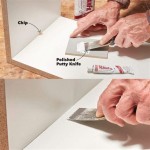Restaining Wood Kitchen Cabinets: A Comprehensive Guide
Wood kitchen cabinets, prized for their warmth and natural beauty, can significantly impact the overall aesthetic of a kitchen. Over time, however, the original finish can fade, become scratched, or simply appear outdated. Restaining wood cabinets is a cost-effective alternative to replacement, allowing homeowners to revitalize their kitchen's appearance without incurring significant expenses. This process involves stripping the old finish, preparing the wood surface, applying a new stain, and sealing it with a protective topcoat. Successfully restaining cabinets requires careful planning, attention to detail, and the proper use of materials and techniques. This article provides a comprehensive guide to restaining wood kitchen cabinets, covering essential steps and considerations.
Assessing the Cabinets and Planning the Project
Before embarking on a restaining project, a thorough assessment of the existing cabinets is crucial. This evaluation determines the scope of work, the necessary materials, and potential challenges. First, the species of wood should be identified. Different wood types absorb stain differently, influencing the final color and application technique. Common cabinet woods include oak, maple, cherry, and pine. Oak, with its open grain, tends to absorb more stain, resulting in a darker, more pronounced grain pattern. Maple, conversely, has a tighter grain and absorbs less stain, yielding a lighter, more uniform appearance. Identifying the wood type will help in selecting the appropriate stain formula and application method.
The condition of the existing finish also needs careful consideration. If the finish is peeling, cracking, or heavily damaged, a more aggressive stripping method may be required. If the existing finish is in relatively good condition, a less intensive cleaning and sanding approach might suffice. It is important to determine if the cabinets were previously painted or stained. Removing paint, especially multiple layers, can be a more labor-intensive process than removing stain. If the cabinets have a thick, glossy finish, it may indicate the presence of a polyurethane or varnish topcoat, which will require a more potent paint stripper or more significant sanding.
Planning the project also involves selecting the new stain color. It's recommended to test stain samples on a hidden area of the cabinet or a scrap piece of similar wood to ensure the desired color and appearance are achieved. The color of the existing wood will influence the final stained color, so a test is essential. Consider the overall kitchen design and desired aesthetic when selecting a stain. Darker stains can create a more dramatic, formal look, while lighter stains can brighten the space and lend a more casual feel.
Finally, gather all necessary materials and tools before beginning the project. This includes paint stripper, sandpaper (various grits), cleaning supplies (such as TSP), stain, a topcoat (polyurethane, varnish, or lacquer), brushes, rags, gloves, safety glasses, and a well-ventilated workspace. Having all materials readily available will streamline the process and minimize interruptions.
The Process of Stripping and Preparing the Cabinets
The first step in restaining wood cabinets is removing the existing finish. This is typically achieved through the use of a chemical paint stripper or by sanding. The choice between these methods depends on the type and condition of the existing finish. For thick, multiple layers of paint or a heavily damaged finish, a chemical stripper is often the preferred method. A chemical stripper softens the old finish, allowing it to be scraped away easily. When using a chemical stripper, it's crucial to follow the manufacturer's instructions carefully and to work in a well-ventilated area, wearing appropriate safety gear, including gloves and eye protection.
Apply the stripper evenly to the cabinet surfaces, allowing it to dwell for the recommended time. Use a plastic scraper to remove the softened finish, being careful not to gouge or damage the wood. For intricate details and corners, a small brush or detail tool can be used to remove the finish. After stripping, clean the cabinets thoroughly with mineral spirits to remove any remaining stripper residue. Proper removal of the old finish is critical for achieving a smooth, even stain application.
Alternatively, sanding can be used to remove the existing finish, especially for thinner finishes or when a chemical stripper is not desired. Start with a coarser grit sandpaper (e.g., 80-100 grit) to remove the bulk of the old finish, then gradually move to finer grits (e.g., 120-180 grit) to smooth the surface. Sand in the direction of the wood grain to avoid creating scratches. A power sander can be used for larger, flat surfaces, but hand sanding is recommended for intricate details and corners. After sanding, remove all dust with a tack cloth or vacuum cleaner.
Once the old finish has been removed, the cabinet surfaces need to be thoroughly cleaned and prepared for staining. Wash the cabinets with a solution of trisodium phosphate (TSP) or a similar cleaning agent to remove any grease, dirt, or grime. Rinse thoroughly with clean water and allow the cabinets to dry completely. Inspect the cabinets for any imperfections, such as dents, scratches, or holes. Fill these imperfections with wood filler and sand smooth once the filler has dried. Finally, lightly sand the entire surface with a fine-grit sandpaper (e.g., 220 grit) to create a smooth, even surface for the stain to adhere to. Remove all dust with a tack cloth before proceeding to the staining process.
Applying the Stain and Protecting the Finish
With the cabinets properly stripped, cleaned, and sanded, the staining process can begin. Before applying the stain, it's often beneficial to use a wood conditioner, especially on softer woods like pine, to help ensure even stain absorption. Wood conditioner helps to prevent blotchiness and uneven color penetration. Apply the wood conditioner according to the manufacturer's instructions and allow it to dry completely before applying the stain.
Apply the stain evenly to the cabinet surfaces using a brush, rag, or sprayer. Follow the grain of the wood and work in manageable sections. For a darker color, apply multiple coats of stain, allowing each coat to dry completely before applying the next. The drying time will vary depending on the type of stain and the environmental conditions. Always refer to the manufacturer's instructions for recommended drying times.
After applying the stain, wipe off any excess stain with a clean rag. This helps to prevent the stain from becoming too dark and ensures a more even color distribution. The amount of time the stain is allowed to dwell on the wood before wiping will affect the final color intensity. Experiment with different dwell times on a test piece to achieve the desired color. For open-grained woods like oak, consider using a grain filler to fill the pores and create a smoother surface. Apply the grain filler according to the manufacturer's instructions and sand smooth after it has dried.
Once the stain has completely dried, apply a protective topcoat to seal the stain and protect the cabinets from wear and tear. Common topcoat options include polyurethane, varnish, and lacquer. Polyurethane is a durable, water-resistant finish that is ideal for kitchens. Varnish is another durable option that provides a warm, traditional look. Lacquer is a fast-drying finish that provides a smooth, high-gloss appearance but is less durable than polyurethane or varnish.
Apply the topcoat in thin, even coats using a brush or sprayer. Allow each coat to dry completely before applying the next. Lightly sand between coats with a fine-grit sandpaper (e.g., 320 grit) to create a smooth, even surface. Apply at least two coats of topcoat for adequate protection. For polyurethane, consider using a water-based formula for easier cleanup and lower VOC emissions. Ensure proper ventilation during the application and drying process. Allow the cabinets to cure completely before reinstalling them. This curing period allows the finish to harden and become more durable.
Hardware should be removed before any staining or topcoat application. Clean and polish all hardware before re-installation on the newly finished cabinets. Ensure all surfaces are completely dust-free and dry before reassembling the cabinets. The result will be revitalized cabinets that are protected for years to come.

Cabinet Refinishing An 8 Step Guide For Pro Painters Ppc

Should I Paint Or Refinish My Kitchen Cabinets

Cabinet Refinishing Guide

Staining Your Wood Cabinets Darker Young House Love

Refinishing Kitchen Cabinets Modern Refacing Made Easy Wisewood

The Fast Affordable Way To Upgrade Your Kitchen Cabinet Refinishing

How To Refinish Wood Cabinets The Easy Way Love Remodeled

Naperville Kitchen Cabinet Refinishers 630 922 9714 Geneva Refacing Resurfacing

Refinish Kitchen Cabinets Without Stripping

Should I Paint Or Refinish My Kitchen Cabinets
Related Posts








